 |
|
|
World War 2 Japanese Military Aircraft, Model Airplanes, Plastic and Diecast Models.
Japanese Military Aircraft section.
of the Prop Fighter Model Department.
in the YellowAirplane store.
| Japanese Military Airplanes |
This page covers model airplanes of the Japanese Military Aircraft, both fighters and Bombers of World War 2.There are many Jap fighters and Jap bombers shown on this page. The A6M Japanese Zeros model airplanes of the Jap zeros showing Japanese airplanes at their best, the Jap zero was the most well know of all Japanese aircraft.The World War 2 A6M Jap Zero is one of the most famous of the Japanese airplanes. This Japanese zero military aircraft is one that attacked Pearl Harbor on Dec 7th, 1941. This aircraft is one of the historic airplanes and would be a great addition to your historic airplane collections. These Japanese airplanes out climbed, out gunned and out maneuvered the American fighter aircraft. However, the Jap Zero was built to be very light and agile. |
|
To do this the design didn't include self sealing tanks, armor around the tanks, armor around the pilot or engine and didn't build the aircraft to withstand the maximum aerodynamic forces. This made the Zeros very easy to shoot down, as many American Pilots attest. One famous battle was the Marianas Turkey Shoot. Another famous Japanese aircraft was a bomber known as the Betty Bomber. This was a medium, twin bomber used in many Japanese cap. Some planes were like the WW2 Japanese Jet Planes, the Baka Bomb. Please Note: The specifications on this page are only for a single model of this airplane. |
| Jet Fighters | WWII Fighters | WWI Fighters | Guitars | Ships |
| Jet Fighters | WWII Fighters | WWI Fighters | Guitars | Ships | Tanks | Motorcycles |
Airplane Calendars * Airplane Art * Aircraft Models * Airplane Books
|
WW2 Japanese Aircraft Types, Click on the type of airplane that you are looking for.
Kawasaki Ki-10 "Perry" Models
KOKUSAI KI-76 "STELLA" Models
Mitsubishi A5M2 Models
Japanese Baka Bomb Models
Nakajima A2N1
Type 90 Models
Tachikawa Ki-9 Type 95 Models
Ki-2 "Louise" Models More Japanese aircraft types are coming, I just need to continue my research. |
|
Japanese Fighter Aircraft. |
|
|
Mitsubishi F-1 Jet Fighter Models
Mitsubishi F-2A Jet Fighter Models
Mitsubishi G4M1 "Betty" Bomber Models
MitsubishiT-2 Jet Fighter Models
Nakajima A6M2 Rufe Seaplane Models
NAKAJIMA
B5M2 Type 97 "Kate" Models
Nakajima B6N2 TENZAM "Jill" Models
Nakajima G8N1 Rita
4 Engine Bomber Models
NAKAJIMA Ki-43 Hayabusa "Oscar" Models
NAKAJIMA Ki-44 Shoki "Tojo" Models
NAKAJIMA Ki-49 Donryu
Type 100 Twin Engine "Helen" Models
NAKAJIMA Ki-84 Hayate "Frank" Models
NakajimaType L2D2 Kinsei Models
NAKAJIMA Type 11 Gekko Twin Engine Models
Tachikawa Ki-54
"Hickory" Models
Tachikawa Ki-55
"Ida" Trainer Models
|
|
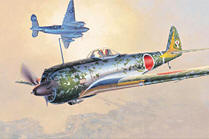 |
|
| B5N2 "Kate" | |
|
Nakajima B5N1 Models Here
Nakajima B5N2 "Kate"
|
|
| B7A2 "Grace" | |
|
Aichi B7A2 "Grace" Models Here Aichi B7A2 Ryusei-Kai Grace
Imperial Japanese Navy carrier-capable, inverted gull wing, dive bomber and torpedo bomber. IJN aircraft: No 53 of the 752nd Naval Air Group at NAS Katori, Chiba Prefecture, May 1945; No 251 of the Yokosuka Naval Air Group at NAS Yokosuka, Kanagawa Prefecture, April 1945 and No 25 of the 752nd Naval Air Group at NAS Katori, Chiba Prefecture, April 1945
Paints Required (Black Yellow Green Brown Silver Neutral
Gray
|
|
| Aichi D3A1 "Val" | |
|
Aichi D3A1 Val 1/72 Die Cast Model" 195" src="images/Japanese_Airplanes_Aichi_D3A1_Val_Model_Kits.JPG" hspace="10" border="1" vspace="4" width="300" height="168" align="left">
Aichi D3A1 Val Models Here
Aichi D3A1 Val
Aichi D3A1 "Val" Dive Bomber The Aichi D3A (Allied code name "Val") was a
World War II dive bomber produced by the Aichi Company in Japan. It was the
primary carrier-borne dive bomber in the Imperial
Aichi D3A1 Type 99 1/48 Kit" 190" src="images/Japanese_Aichi_D3A1_Type_99_WWII_Airplane.jpg" border="1" hspace="10" vspace="4" width="300" height="129" align="left">The Aichi dive bomber that flew from the Imperial Japanese Navy
carrier Soryu during the December 7, 1941, attack on Pearl Harbor. It carried a 250kg
bomb under the fuselage.
The Aichi was a carrier-borne bomber responsible for bombing the first targets
at Pearl Harbor. Known as the Val to the Allies, the D3A1 had a tapered
elliptical wing for aerodynamic efficiency. The plane was built with a Kinsei 44 radial engine
Paint Required (Yellow Green Brown Silver Neutral Gray Steel Flat
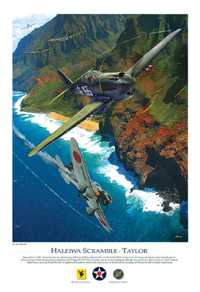 0071824 0071824Haleiwa Scramble - Taylor Dan Zoernig. Flying a P-40B Tomahawk of the 47th Fighter Squadron stationed at Haleiwa Field, 2nd Lt. Kenneth M. Taylor downs an Aichi D3A1 "Val" dive bomber en route to the Marine base at Ewa Field during Japan's December 7, 1941, attack on Pearl Harbor. Taylor and his squadron mate, 2nd Lt. George Welch, made two flights over Hawaii that day and were the first officially decorated U.S. heroes of World War II. Limited edition 13"x 19" print is signed and numbered by the artist. #0071824 |
|
| Kugisho D4Y4 "Judy" | |
|
Japanese Kugisho D4Y4 "Judy" Dive Bomber Model" 196" src="images/Japanese_D4Y4_Judy_Imperial_Navy_Dive_Bomber.jpg" border="0" hspace="10" vspace="4" width="300" height="177" align="left">
IJN Bomber Kugisho D4Y4 JUDY Models Here The Imperial Japanese Navy's D4Y was one of the fastest dive-bombers of World War II. One of its variants, the D4Y4 Model 43, even served as a single seat kamikaze Special Strike Bomber. Aichi Atsuta AE1P V12 piston engine. Kugisho D4Y2-S "Judy" Suisei 12 fighter
A Kamikaze airplane attacks the USS Laffey DD-724 Destroyer in WW2" 197" src="../Models_Ships/images/USS_Laffey_DD-724_Destroyer_Attack_by_Kamikaze.jpg" border="1" hspace="10" vspace="4" width="400" height="311" align="left"> D4Y4 "Judy" Aviation Art.
0072076 Tom Freeman. Despite being struck by four bombs and five kamikazes - four
Aichi 3DA "Vals" and one D4Y4 "Judy"
- off the coast of Okinawa on April 16, 1945, the Sumner-class destroyer USS
Laffey (DD-724) refused to die - and is still afloat as a museum ship in South
Carolina. 30"x 24", limited edition print is signed and numbered by the artist. |
|
| G3M2 Rikko "Nell" | |
|
G3M2 Type 96 Rikko (Nell) Models Here
Performance Maximum speed: 375 km/h (233 mph; 202 kn)
G3M1 Model 11
G3M2 Model 21
G3M2 Model 22
G3M3 Model 23 |
|
|
|
|
|
Click Here to see the
Betty Bomber Exhibit G4M Betty Bombers on Wikipedia
Role Medium Range Bomber
The Mitsubishi G4M Isshikirikko or the type 1 land-based attack bomber, was built to a range-at-all-cost specification. In order to compensate for the inferior fleet strength restricted by the London and Washington Treaties, the Imperial Japanese Navy intended to support their naval operations from shore based aircraft. The Betty Bomber had high aspect ratio wings and fat cylindrical fuselage which were characteristics of this aircraft. |
|
|
|
|
| Mitsubishi Ki-21 "Sally" | |
|
Role Medium bomber The Aircraft's Specifications The MITSUBISHI ARMY TYPE 97 HEAVY BOMBER Ki-21 was better known in the West as the SALLY. Designed to a 1936 Imperial Japanese Army Air Force requirement and entering operational service in 1939, the SALLY saw combat action throughout the war despite inadequate armament and armor protection. When production ceased in September 1944, over 2,000 Sally's had been built, and like many Japanese aircraft, ended the war serving as a Kamikaze platform. Mitsubishi Ki-21 Sally Aviaton Art Picture by Paul Wollman" 198" src="images/Japanese_Mitsubishi_Ki-21_Sally_Bomber_Aviaton_Art_Paul_Wollman.jpg" border="1" hspace="10" vspace="4" width="300" height="201" align="left">Mitsubishi Ki-21 "Sally" Aviation Art.
0070241 |
|
| Nakajima Ki-27 "Nate" | |
|
Japanese WW2 Nakajima Ki-27 "Nate" Airplane" 215" src="images/Japanese_Ki-27_Nate_Nakajima_Airplane_WWII.jpg" border="1" hspace="10" vspace="4" width="300" height="222" align="left">
Ki-27 1/72
Scale Models Here
Ki-27 1/48 Scale Models Here
Ki-27 1/32 Scale Models Here
Ki-27 Books Here
The star performer in the aviation portion of the Manchurian incident of the late '30's, this was about the best fighter of the time. This 'little Japanese fighter was probably one of the very best in the world at the time it was first built in 1937. It was a classic low wing, fixed gear, light weight, highly maneuverable design. In addition, in service it was painted up in what would appear to be very attractive color schemes. "In 1935, the Japanese Army held a competition between
Nakajima, Mitsubishi, and Kawasaki to design a low-wing monoplane to replace the
Kawasaki Ki-10 (Type 95 Fighter) biplane. The results were Nakajima Ki-27,
Kawasaki Ki-28, and Mitsubishi Ki-33. Nakajima's design was based on its earlier
Ki-11 monoplane fighter which lost to Ki-10 in the Type 95 Fighter competition,
and Ki-27 was designed by Koyama Yasushi to have air-cooled radial engine and
fixed landing gear. 1st Sentai commander Toshio Kato A largely forgotten war was waged between the Russians and Japanese in Mongolia. At the outset of the war, the Ki27 outclassed everything the Russians had in the area. Many of Japan's fiercest aces downed their first opponents at the battle of Khalkhin Gol while flying the Ki27. The Japanese ended up losing the battle but wreaked tremendous havoc on the Russian Air Forces, claiming a total of 1,340 kills. Flying Tiger aces of World War II" 229" src="images/P-40_Flying_Tiger_Ace_Aviation_Art_Picture_Stan_Stokes.jpg" border="1" hspace="10" vspace="4" width="300" height="204" align="left">0007246Tigers Claws Stan Stokes. Aviation Art Ken Jernstedt, one of 39 Flying Tiger aces of World War II with 10
confirmed victories, has just defeated a Japanese Nakajima Ki-27 "Nate." 16"x
11"print is signed and numbered by the artist. |
|
| Nakajima Ki-43 "Oscar" Hayabusa | |
|
Ki-43 1/72 Scale Models Here
Ki-43 1/48 Scale Models Here
Ki-43 1/32 Scale Models Here
Ki-43 Aviation Art Prints Here
Introduced in 1939, the Nakajima Ki-43 Hayabusa (Peregrine Falcon) was the most
widely used Imperial Japanese Army Air Force fighter of World War II.
0005944 Japans Nakajima Ki-43 Hayabusa in JAAF Service" 216" src="images/Japanese_Nakajima_Ki-43_Hayabusa_Fighter_Airplane.jpg" border="1" hspace="10" vspace="4" width="200" height="265" align="left">
0001391
Ki-43 Oscar There were 5919 KI-43 Hayabusas were produced prior to August, 1945 - second only in production numbers to the Japanese Navy's Mitsubishi A6m "Zero" the Nakajima HA-25 / NK-1 Army Type 99 radial engine "Sakae" or one of the more powerful Nakajima HA-115 variants used on "Oscar" many were expended in Kamikazi usage late in the war and very few still exist today. 0071812 Ki-43 Oscar Aces of World War 2" 209" src="images/Japanese_Ki-43_Oscar_Hayabusa_Peregrine_Falcon_Fighter_Airplane.jpg" border="1" hspace="10" vspace="4" width="200" height="270" align="left"> 0015487 Ki-43 Oscar Aces of World War 2 Aircraft of the Aces Vol. 85 Ichimura. This heavily illustrated book examines the World War II service of the Ki-43 Hayabusa (Peregrine Falcon) - Japan's most prolific fighter, which, in frontline IJAAF service until war's end, produced more aces than any other plane - as well as the pilots who became an ace flying it. 96 pages, B&W photographs and color illustrations, 7"x 9", softcover. #0015487 |
|
| Nakajima Ki-44 Shoki "Tojo" | |
|
Ki-44 1/72 Scale Models Here
Ki-44 1/48 Scale Models Here
Ki-44 Aviation Art Prints
Ki-44 Aviation Books
Nakajima
Ki-44 Shoki (Tojo) Webmasters Note: Look at the similarity of this plane to the American fighter the P-47 Thunderbolt. P-47 Thunderbolt models Located Here Threatening Skies, a Japanese Ki-44 Richard Taylor Aviation Art Print" 227" src="images/Japanese_Ki-44_Richard_Taylor_Aviation_Art_Picture.jpg" border="0" hspace="10" vspace="4" width="200" height="237" align="left">
0077099
Thunder in the East, P-47 Thunderbolt Attack" 228" src="images/P-47_Thunderbolt_Richard_Taylor_Print.jpg" border="1" hspace="10" vspace="4" align="right" width="400" height="286">0077447 On October 20, 1944, a composite air force made up of
P-47 Thunderbolts from RAF 261 and 146 Squadrons strafed a vital Japanese
stronghold at Mingaladon Airfield near Rangoon, Burma. Here, after completing
his bombing attack, Warrant Officer Thomas "Lucky" Carter, flying his
distinctive P-47 "Pistol Packin' Mamma," engages Nakajima Ki-43 Oscars and Ki-44
Tojos. A fitting tribute to those who fought in that Burma campaign, this 31"x
21", limited edition print has been signed by the artist and three RAF veterans
that fought in the Burma campaign (two pilots that flew Thunderbolts in Burma
and one of the vital ground crewmen that prepared the P-47s for strafing
Mingaladon).
Ki-44 'Tojo' Aces of World War 2" 210" src="images/Japanese_Ki-43_Army_Air_Force_Fighter_Airplane.jpg" border="1" hspace="10" vspace="4" width="200" height="270" align="left"> |
|
| Kawasaki Ki-45 Toryu "Nick" | |
|
Ki-45 1/109 Scale Diecast Models
Ki-45 1/72 Scale Models
Ki-45 1/48 Scale Models
Ki-45 Collectable and Post Cards The Ki-45KAIb was specifically developed as a ground attack aircraft, hence the 20mm nose cannon in addition to the 37mm ventral cannon. This relatively heavy forward firepower made it perfect for hunting PT boats or intercepting 5th AF Liberators. The top speed was 340 mph, range about 1,400 miles and a little over 1,700 aircraft were built. One was experimentally fitted with a 75mm cannon, but it proved too much for the light airframe of the Ki-45. Kawasaki's Ki-45 Toryu or, "Nick" as it was known to the allies. There were about 1700 of the airplanes built which served the Japanese Army from mid-1942 until the end of hostilities in 1945. The aircraft was unusual for the Japanese in 1942 in that in had protected fuel tanks and was fairly well armed...the Kai Koh version had two nose mounted 12.7mm Type 1 (Ho-103) machine guns and 7.9mm Type 98 gun on a flexible mount firing from the rear crew station. Its real punch came from a 20mm cannon that was mounted in the belly which was put to good use in anti-shipping sorties. Armament and engines were improved on throughout the Ki-45's production run though its flight performance as a fighter was less than spectacular. The twin-engine Ki-45 was designed to carry a heavy armament on long-range missions. They were clumsier than single engine fighters, but a 37 mm cannon made them highly effective against bombers. One of the air groups deployed by Japan shot down eight B-29s on its first mission. The Ki-45 took a heavy toll of bombers, ships and men before becoming obsolete as more single-engine fighters arrived with American carriers. The Ki-45 served with the 1st Company, 5th Chutai apparently in home defense duties. The origins of the Kawasaki Ki-45 are interesting, as it was a plane that almost wasn't. There were all sorts of problems much of them relating to tail flutter and lack of general stability. There was also a lack of power from the chosen engines. As this aircraft was also being developed concurrently with the Ki-48 and using many of the same components, similar problems cropped up with the Ki-48. Eventually the airframe was modified and more powerful engines used bring the aircraft up to specifications. In the 1930s, when many nations were looking at twin engined designs for fighters, Kawasaki followed the pack with their original Ki-45 design. The performance was severely lacking, and while this initial design was rejected, the Japanese government did provide suggestions for improvement. Kawasaki wisely decided to hand the project off to Doi Takeo, the designer who came up with the successful Ki-48 bomber. The result was a significant departure from the original Ki-45, and the Ki-45kai exceeded the IJA specifications.
Kawasaki Ki-45 battles a B-29 Superfortress" 232" src="images/Japanese_Kawasaki_Ki-45_Toryu_B-29_Super_Fortress.jpg" border="1" hspace="10" vspace="4" width="300" height="196" align="left"> Click Here, a high-flying B-29 unleashes its fury while dodging the Kamikaze attack of a Kawasaki Ki-45 Toryu ("Nick"), one of the few Japanese fighters capable of reaching the B-29's altitude. 16"x 11" limited edition print. #0007758
Many More Stan Stokes Pictures Here
Japanese Ki-45 Kai Hei Toryu, Nick, battles two F4U Corsairs" 200" src="images/Japanese_Ki-45_Kai_Hei_Toryu_Nick_Fighter_Airplane.jpg" border="1" hspace="10" vspace="4" width="300" height="220" align="left"> At dawn, on May 10, 1945, 100 miles north of Okinawa, two Marine F4U
Corsairs from VMF-312, led by then Capt. Ken Reusser, successfully engaged a
Japanese Ki-45 Kai Hei Toryu (Nick). 24"x 18" limited edition print is signed
by the artist and Col. Ken Reusser. |
|
| Mitsubishi Ki-46 "Dinah" | |
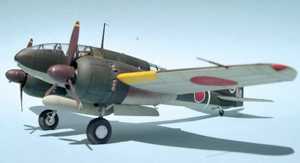 Ki-46 Everything
Ki-46 1/72 Scale Models
Ki-46 1/48 Scale Models Mitsubishi Ki-46 "Dinah"
This aircraft was first used by the Japanese Army in
Manchukuo and China, where seven units were equipped with it, and also at times
by the Japanese Imperial Navy in certain reconnaissance missions over the
northern coasts of Australia and New Guinea. |
|
| Kawasaki Ki-48 Sokei "Lili" Type 99 | |
|
Ki-48 1/48 Scale Decals & Paint Mask
75th Sentai (Fight Regiment), 3rd Chutai (Company),
Indonesia 1944
The Day I Owned the Sky" 233" src="images/P-40_Warhawk_Col_Robert_Scoitt_Jr_Ace.jpg" border="1" hspace="10" vspace="4" width="300" height="198" align="left">0071993 |
|
| Nakajima Ki-49 Donryu "Helen" | |
 Nakajima Ki-49 Donryu (Helen) Nakajima Ki-49 Donryu Japanese Bomber" 220" src="images/Japanese_Ki-49_Nakajima_Donryu_High_Speed_Bomber.jpg" border="1" hspace="10" vspace="4" width="200" height="262" align="left">
0002593 | |
| Kawasaki Ki-61 HIEN "Tony" | |
|
Kawasaki Ki-61 Tony
Kawasaki Ki-61 Hien "Tony" 1/72 Die Cast Model" 205" src="images/Japanese_Ki-61_Kawasaki_fighter_Plane_Tony.jpg" border="0" hspace="10" vspace="4" width="300" height="253" align="left">
Ki-61 1/72 Scale Models
Ki-61 1/48 Scale Models
Ki-61 1/32 Scale Models a Ki-61 Hien - which was the only mass-produced Japanese fighter of World War II to use a liquid-cooled, inline V engine - flown by 8-victory ace Capt. Teruhiko Kobayashi, commander of the 244th Sentai, in early 1945. Kawasaki Ki-61 Hien "Tony" HQ Chutai, 244th Sentai, Chofu, Tokyo, Winter 1944-1945 The KAIc variant of the Japanese Ki-61-I, which first appeared in 1944, primarily flew against Allied bombers in the defense of Japan. Ki-61 "Tony" flown by the 244th Sentai's HQ flight out of Chofu Air Base near Tokyo in 1944-45. Kawasaki Ki-61 Hien WW2 Fighter Airplane" 204" src="images/Japanese_Ki-61_Kawasaki_Hien_JAAF_Fighter.jpg" border="1" hspace="10" vspace="4" width="200" height="264" align="left">
0001390
Ki-61 Hien Tony Fighter Airplane" 211" src="images/Japanese_Ki-61_Hien_Tony_Fighter_Airplane.jpg" border="1" hspace="10" vspace="4" width="300" height="253" align="right">0008530 Codenamed "Tony" by the Allies, the Ki-61 Hien was the only fighter
with a liquid-cooled engine fielded by the Japanese Army during WWII, and was
one of the few interceptors that could reach the altitude of the B-29
Superfortresses. Here, in a desperate maneuver after exhausting his ammunition
on American bombers in flight over Japan, Japanese Corporal Nakano rams the tail
of a huge B-29 in an attempt to bring it down. 23"x 19" print. 0071821 Following a scrape with a B-29, the pilot of a home defense Ki-61,
watched over by his wingman, prepares to bail out off of the Japanese Coast as
fuel vapor streams from his wing tanks. 19"x 13" limited edition print is signed
and numbered by the artist.
Webmasters Note: The first thought to come to my mind when I see this aircraft is the German Messerschmitt ME-109 Fighter Aircraft Click Here to see the Me-109 Models Also this looks like the P-51A |
|
| Mitsubishi Ki-67 "Peggy" | |
0002594
0075045 Torpedo-equipped Imperial Japanese Army Ki-67 "Peggy" bombers
attack the U.S. Navy cruiser USS Houston (CL-81) off the coast of Formosa at
sunset on October 14, 1944. 36"x 24", limited edition print is signed and
numbered by the artist.
Mitsubishi
Ki-67 Peggy |
|
| Nakajima Ki-84 Hayate "Frank" | |
|
Nakajima
Ki-84 Hayate Nicknamed the Frank by the Allies, the Hayate proved an effective interceptor against B-29s over the Japanese mainland. 18-cylinder Hoshi HA-45 engine The Imperial Japanese Army Air Force’s NAKAJIMA ARMY TYPE 4 FIGHTER (also identified as the Ki-84) was better known in the West as the FRANK and was held in high regard by the American pilots who fought against it. Designed to combine the maneuverability of the earlier Ki-43 Hayabusa with upgraded performance to match the best western fighters, the heavily-armed Ki-84 first flew in March 1943. Although the design was solid, the shortage of fuel and construction materials, poor production quality, and lack of skilled pilots prevented the fighter from reaching its potential. A total of 3,514 were produced. 0048001
Nakajima Ki-84 Frank
0001386
Nakajima Ki-84 Hayate (Frank) |
|
|
Kawasaki Ki-100 "Tony" |
|
|
Kawasaki
Ki-100 "Fast Back" Tony a Ki-100 "Tony" flown by the Imperial Japanese Army in World War II. IJA markings (5th, 59th and 244th Sentais)
0019966 |
|
|
Aichi M6A1 Seiran Developed by the Japanese Navy to fly off I-400 and I-401 submarines, the Aichi M6A1 Seiran had floats for landing next to its sub and folding wings for compact storage.
Aichi
M6A1 Seiran 1/72 Kit |
|
Kawanishi N1K2-J Shiden-Kai (George) Kawanishi N1K2-J Shiden-Kai "George" of the famous 343rd Kokutai led by Capt. Minoru Genda |
|
| Kawasaki T-4 Japanese Jet Fighter | |
|
|
|
Pearl Harbor 0755... While the Giant
Slept Aviation Art Print Dru Blair. Lt. Commander Kakuichi Takahashi rolls his Aichi D3A1 Type 99 "Val" dive-bomber, lining it up with Hangar 6 on the southern tip of Ford Island to initiate the Pearl Harbor attack… and change America forever. 30"x 24" limited edition print is signed and numbered by the artist and includes a legend map for easy identification of numerous landmarks. |
|
|
Lance of the Samurai with a Free Military Diecast Model Plane Pre Built Japanese Military Model Plane and Free Aviation Art Picture. Stan Stokes. The N1K2-J Shiden-Kai "George" flown by CPO Shoichi Sugita of the 343rd Kokutai (see item #6328) claims four F6F Hellcats and another three probable's during the shredding of an unsuspecting and overconfident carrier strike group near Kure on March 19, 1945. 16"x 11" limited edition print is signed and numbered by the artist. Kawanishi N1K2-J Shiden-Kai 1/72 Die Cast Model a Kawanishi N1K2-J Shiden-Kai "George" of the famous 343rd Kokutai led by Capt. Minoru Genda (see items 6328 and 73024), this 1/72 scale die cast model is the first opportunity to add this top fighter to your collection. Your model will include engraved panel lines, a clear cockpit canopy, wing-mounted cannons, optional position landing gear, authentic markings, and more. 6" wingspan; includes a display stand. |
|
0036228 |
|
Discount Insurance Discount Travel
|
. |
|
|
0007159 Awakening the Giant C.S. Bailey. Japanese Zeros from the Imperial Japanese Navy's flagship carrier Akagi proceed to the opening strike at Pearl Harbor, December 7, 1941. 26"x 20" limited edition print is signed and numbered by the artist. 0007159 |
|
|
0007271 Battleship Row Aviation Art Print, Naval Art Print Stan Stokes. Depicts the December 7, 1941 attack at Pearl Harbor. A Japanese "Kate" from the Akagi launches a Kai Model 2 torpedo at the USS West Virginia during the attack. 16"x 11" limited edition print is signed and numbered by the artist. 0007271 |
|
|
0073024 Lance of the Samurai Stan Stokes. Aircraft Art Print Picture. Stan Stokes. The N1K2-J Shiden-Kai "George" flown by CPO Shoichi Sugita of the 343rd Kokutai (see item #6328) claims four F6F Hellcats and another three probables during the shredding of an unsuspecting and overconfident carrier strike group near Kure on March 19, 1945. 16"x 11" limited edition print is signed and numbered by the artist. #0073024 |
|
|
Click Here to see Many moreJapanese
Fighters and Bombers. Click Here to see the Betty Bomber Japanese Surrender Exhibit. Click Here to see the Japanese Propaganda Art Exhibit Click Here to See Japanese Ships Click Here to See the Japanese Mini Sub on Guam Here to See Japanese Model Tanks |
|
Japanese Surrender Exhibits |
|
|
Betty Bombers on Ie Shima
This exhibit shows the Japanese Betty Bombers that were the first part of Japan's Surrender to the U.S. in World War 2. This is a big part of the Surrender of Japan that is very little known and not very well published, but is a big part of the history of WW2 Exhibit Added 15 Feb 2004 |
 |
|
Aerial Photos,
of the island of Ie Shima. These photos compare the runways of 1940's Ie Shima to the photos of Ie Shima today. Ie Shima was the home to the 34th Fighter Squadron in World War 2. Exhibit Added 3 Feb 2004 |
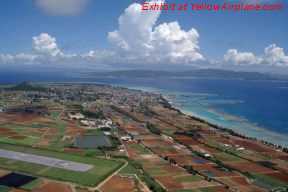 |
|
Click Here's the New Ernie Pyle Exhibit. Ernie Pyle was probably the most famous War
Correspondent of World War 2. He died on
the island
of Ie Shima located in the Western Pacific near Okinawa. This
exhibit has exclusive photos and stories about Ernie Pyle including the
story about Exhibit Added 14 June 2007 |
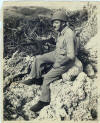 |
|
Look Here at the
True Story of the Surrender of Japan, What most People Don't Know
|
 |
|
Japanese Propaganda Art Exhibit Propaganda Art was used by forces on all sides in
WW2 as well as all wars in history. This kind of art gave pride to the
citizens of those countries who produced it and gave a unity in support
of the wars. This exhibit is an excellent example of Japanese
Propaganda art. |
 |
Mitsubishi F1M-2 Pete Seaplane. The Type-O seaplane was a biplane designed to a Japanese Navy requirement for an observation and reconnaissance aircraft, also capable of defending itself when faced with fighter opposition. Used throughout WWII, it was successfully used to hunt and destroy enemy submarines in addition to its reconnaissance tasks. |
|
the Imperial Japanese Kawanishi H8K EMILY Flying Boat. Used for maritime
patrol duties, the H8K entered production in late 1941 and first saw operational
use on the night of March 4, 1942 staging a second raid on Pearl Harbor. Since
the target lay out of normal range for the flying boats, this audacious plan
involved a refueling by submarine en route at French Frigate Shoals – an overall
mission distance of almost 5,000 miles. Incredibly, two EMILYs actually made it
to Hawaii and bombed the island of Oahu! The improved H8K2 variant soon
appeared, and its extremely heavy defensive armament earned it the nickname
"Flying Porcupine" among Allied aircrews. This was to be the definitive variant,
with 112 produced, and they were used on a wide range of patrol, reconnaissance,
bombing, and transport missions throughout the Pacific war. Nearly 40 examples
of a dedicated transport version, the H8K2-L, were also built, capable of
carrying 62 troops. Overall, a total of 167 EMILYs were produced, and only four
survived until the end of the war. Hiroyoshi Nishizawa - the Japanese "Naval Ace of Aces." Kawanishi N1K2-J Shiden-Kai "George" of the famous 343rd Kokutai led by Capt. Minoru Genda Mitsubishi A6M2 Zero Saburo Sakai the A6M2 Zero flown by 64-victory ace Saburo Sakai, who, with Hiroyoshi Nishizawa (113 victories) and Toshio Ohta (34), formed the elite Tainan Ku's famous "Ace Trio,"
"AI-102," Akagi, 1st KK, 1st KS, Pearl Harbor A6M2 Zero 261st NAC, Shigeru Itaya, IJN Carrier Akagi, Pearl Harbor A6M2 Zero flown by Lt. Commander Shigeru Itaya, who led the first wave covering force from the IJN carrier Akagi during the Japanese attack on Pearl Harbor 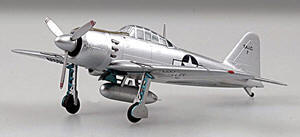 Mitsubishi
A6M5b Mitsubishi
A6M5b TAIC, 1944 - Captured Aircraft In mid-1944, U.S. Navy personnel were withdrawn from the Allied Technical Air Intelligence Unit (ATAIU) - which was formed in 1942 to recover Japanese aircraft and obtain intelligence on their technical and tactical capabilities - and reassigned to the U.S. Technical Air Intelligence Centre (TAIC) at NAS Anacostia to coordinate the work of test centers in preparation for the planned invasion of Japan. A Mitsubishi A6M5b Zero that - captured on the island of Saipan - was tested by the Technical Air Intelligence Centre in 1944, Stan Stokes. The N1K2-J Shiden-Kai "George" flown by CPO Shoichi Sugita of the 343rd Kokutai (see item #6328) claims four F6F Hellcats and another three probable's during the shredding of an unsuspecting and overconfident carrier strike group near Kure on March 19, 1945. Mitsubishi F1M-2 Pete Seaplane. The Type-O seaplane was a biplane designed to a Japanese Navy requirement for an observation and reconnaissance aircraft, also capable of defending itself when faced with fighter opposition. Used throughout WWII, it was successfully used to hunt and destroy enemy submarines in addition to its reconnaissance tasks. |
Click Here for the Full Aviation Art Collection at YellowAirplane.com
Click Here to see the Japanese Propaganda Aviation Art Exhibit
HO Scale Trains
Bachmann EZ Train Track Controls
* Belt
Sanders * Glue
Guns * Heat Guns
* Lathes *
Paint
* Vices
* Xacto Knives
| Corvettes for Sale
Take a look at the Yellow Airplane Historical and Technical Museum |
|
|
|
|
| . |
| . |
/Models_Fighters/D_Japanese_Airplanes.html|27040"
Copyright Dates:
11-17-2010 10-11-2012 1-15-2014
| . |